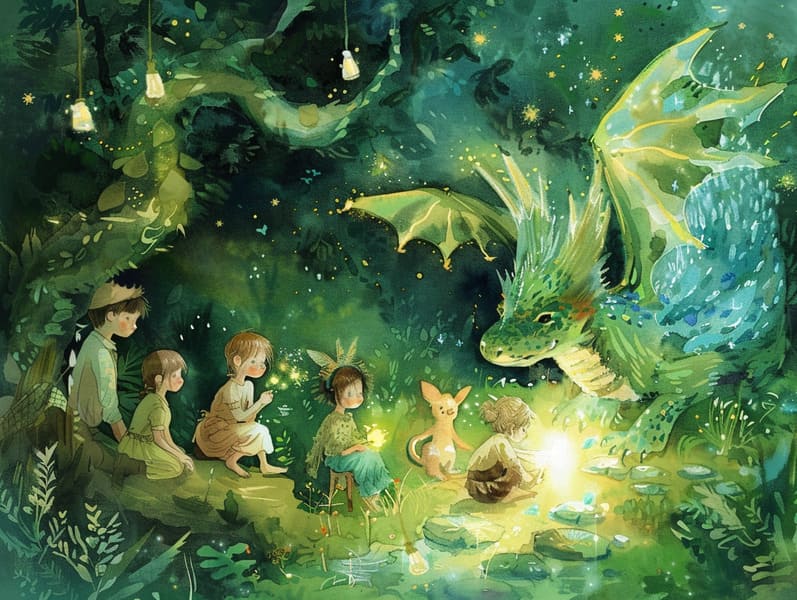
Grimm's fairy tales have historical significance. These tales have been narrated from one generation to the next ages before they were ever documented. They came from a variety of civilizations, including European traditions. They were initially disseminated among mature audiences, often carrying themes and messages related to the societal norms and beliefs of the time.
The renowned Brothers Grimm, Jacob and Wilhelm, were among the first to assemble many of these beloved narratives. Their volume, "Grimm's Fairy Stories," included stories like "The Story of Cinderella," "The Story of Hansel and Gretel," and "The True Story of Snow White," which have since become cornerstones in the world of traditional fairy tales. Similarly, Hans Andersen's delightful stories, such as "The Little Mermaid," and "The Duckling's Story," have gained the love worldwide, ensuring their place in the pantheon of beloved fairy tales.
Despite being ancient, these stories remain as pertinent as ever, especially as children's bedtime stories. These magical stories are now available in many formats, including richly illustrated books, whimsical animations, and web-based fairy tales.
Their lasting presence can be traced to several captivating elements:
Vital Lessons: Ancient fairy tales often provide important moral lessons. Fairy tales like "The Boy Who Cried Wolf" teach the virtue of truth, while "The Tortoise and the Hare" show the merits of resolve and modesty. These narratives offer little ones clear distinctions between virtue and vice, guiding their moral compass in a soft yet deep way.
Compassion and Insight: Traditional fairy tales frequently feature individuals facing trials and tribulations, encouraging young readers to relate with their struggles and champion their triumphs. For instance, "The Tale of Beauty and the Beast" shows us the significance of valuing inner qualities to recognize the true essence of a soul, cultivating warmth and awareness.
Cultural Recognition: Many ancient fairy tales are infused with the cultural contexts from which they emerged. Exploring these stories can provide fascinating glimpses into different beliefs, encouraging a sense of global insight and discernment.
Creativity and Imagination: The magical elements in classic fairy tales—wizardry and magic—stimulate children’s dreams. These tales guide readers to supernatural realms, inspiring fantastical thinking and a sense of awe that remains a lifetime.
Traditional fairy tales are not only captivating but also teaching. They serve as entrancing tools in building various intellectual and emotional capacities in little ones. When classic fairy tales are told out loud, they boost language acquisition by offering new words and complicated sentence structures. This practice also boosts auditory skills and attention, as young readers concentrate deeply, prepared to see what happens next.
Furthermore, examining the themes and characters of timeless fairy tales can promote problem-solving abilities and intellectual skills. Little ones are led to spot patterns, predict happenings, and catch on to cause and effect. These debates also aid the young reveal their thoughts and feelings, boosting their emotional intelligence.
In today’s online age, the accessibility of digital fairy tales has made these stories more obtainable than ever. Online platforms and programs offer comprehensive collections of traditional fairy tales that can be experienced or listened through anytime, anywhere. Fairy tales read aloud are particularly well-liked, giving an enjoyable way for little ones to appreciate these captivating stories. Spoken stories and voiced videos transport characters and settings to life, often supported by fantastical musical scores and music that improve the story journey.
The everlasting appeal of traditional fairy tales lies in their ability to modify to modern society while sustaining their fundamental ideas. Contemporary versions of these fairy tales often introduce more diverse protagonists and modern settings, making them pertinent to today’s audience. However, the fundamental themes of fortitude, benevolence, and impartiality remain unchanged, continuing to touch readers of all ages.
Fairy tales also offer a sense of calm and knowability. They afford a systematic narrative with a apparent beginning, middle, and end, often closing with the finalization of conflicts and the triumph of good over evil. This consistency can be solacing for the young, showcasing a sense of security in an unpredictable world.
Old fairy tales continue to fascinate and train new generations, maintaining their enchantment read more and relevance in modern society. As bedtime stories for kids, they afford a perfect blend of fascination and comprehension, nourishing moral values, empathy, and creativity. The proliferation of free fairy tales online and the sought after status of fairy tales read aloud promise that these traditional tales remain within reach to new generations.
By continuing and making known these fairy tales, we continue to esteem the rich tapestry of folklore and cultural heritage. Whether you are viewing a artistically illustrated book, browsing a cyber library, or listening through an read-aloud book, the elegance of famous fairy tales is always within reach. These narratives illustrate of the steadfast effect of tales and its ability to gather us across epochs and places.
Regardless if you are accessing a artistically illustrated book, accessing a online library, or listening via an narrated book, the radiance of bedtime fairy tales is always within reach.
These tales convey of the timeless essence of stories and its ability to bring us together across generations and cultures, forging a link that delights and instructs alike.